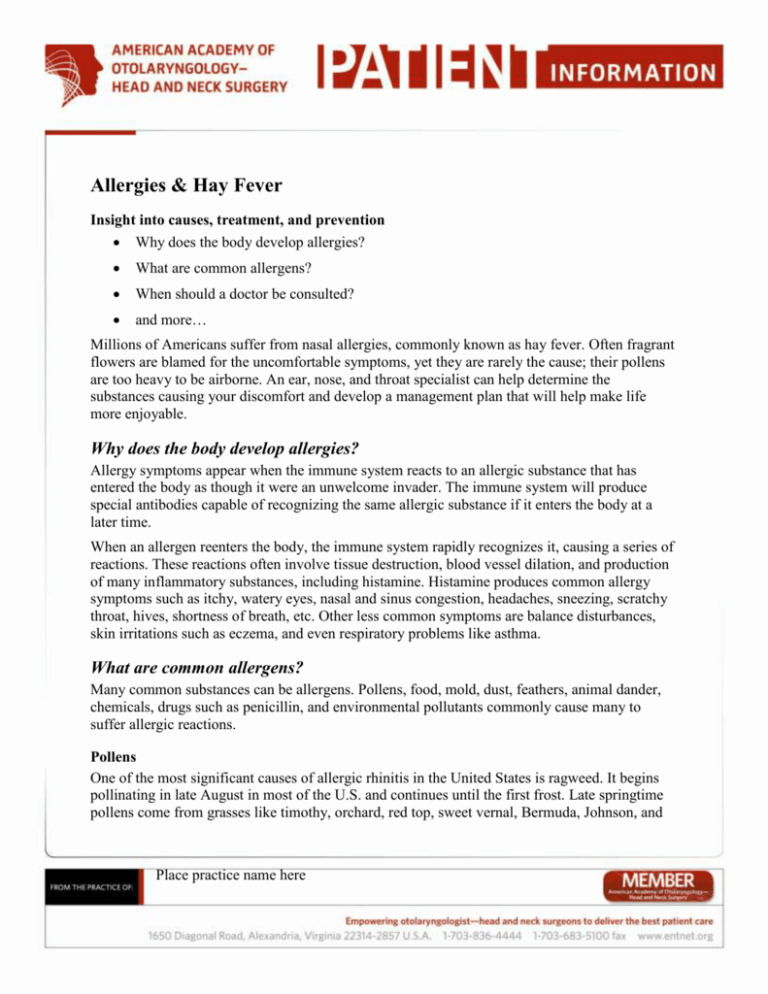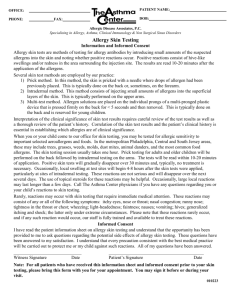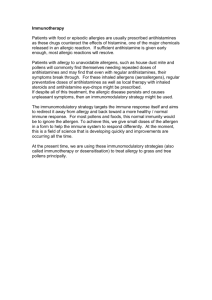Allergies & Hay Fever
advertisement

Allergies & Hay Fever Insight into causes, treatment, and prevention Why does the body develop allergies? What are common allergens? When should a doctor be consulted? and more… Millions of Americans suffer from nasal allergies, commonly known as hay fever. Often fragrant flowers are blamed for the uncomfortable symptoms, yet they are rarely the cause; their pollens are too heavy to be airborne. An ear, nose, and throat specialist can help determine the substances causing your discomfort and develop a management plan that will help make life more enjoyable. Why does the body develop allergies? Allergy symptoms appear when the immune system reacts to an allergic substance that has entered the body as though it were an unwelcome invader. The immune system will produce special antibodies capable of recognizing the same allergic substance if it enters the body at a later time. When an allergen reenters the body, the immune system rapidly recognizes it, causing a series of reactions. These reactions often involve tissue destruction, blood vessel dilation, and production of many inflammatory substances, including histamine. Histamine produces common allergy symptoms such as itchy, watery eyes, nasal and sinus congestion, headaches, sneezing, scratchy throat, hives, shortness of breath, etc. Other less common symptoms are balance disturbances, skin irritations such as eczema, and even respiratory problems like asthma. What are common allergens? Many common substances can be allergens. Pollens, food, mold, dust, feathers, animal dander, chemicals, drugs such as penicillin, and environmental pollutants commonly cause many to suffer allergic reactions. Pollens One of the most significant causes of allergic rhinitis in the United States is ragweed. It begins pollinating in late August in most of the U.S. and continues until the first frost. Late springtime pollens come from grasses like timothy, orchard, red top, sweet vernal, Bermuda, Johnson, and Place practice name here some bluegrasses. Early springtime hay fever is most often caused by pollens of trees such as elm, maple, birch, poplar, beech, ash, oak, walnut, sycamore, cypress, hickory, pecan, cottonwood, and alder. Flowering plants rarely cause allergy symptoms. Household allergens Certain allergens are present all year long. These include house dust, pet danders, and some foods and chemicals. Symptoms caused by these allergens often worsen in the winter when the house is closed up, due to poor ventilation.. Mold Mold spores also cause allergy problems. Molds are present all year long and grow both outdoors and indoors. Dead leaves and farm areas are common sources for outdoor molds. Indoor plants, old books, bathrooms, and damp areas are common sources of indoor mold growth. Mold is also common in foods. How can allergies be managed? Allergies are rarely life-threatening, but often cause lost work days, decreased work efficiency, poor school performance, and a negative effect on the quality of life. Considering the millions of dollars spent on antiallergy medications and the cost of lost work time, allergies cannot be considered a minor problem. For some allergy sufferers, symptoms may be seasonal, but for others they produce year-round discomfort. Symptom control is most successful when multiple approaches are used simultaneously to manage the allergy. They may include minimizing exposure to allergens, desensitization with allergy shots or drops, and medications. If used properly, medications, including antihistamines, nasal decongestant sprays, steroid sprays, saline sprays, and cortisonetype preparations, can be helpful. Even over-the-counter drugs can be beneficial, but some may cause drowsiness. When should a doctor be consulted? The most appropriate person to evaluate allergy problems is an otolaryngologist (ear, nose, and throat specialist). Aside from gathering a detailed history and completing a thorough examination of the ears, nose, throat, head, ENT doctors will offer advice on proper environmental control. They will also evaluate the sinuses to determine if infection or structural abnormality (deviated septum, polyps) is contributing to the symptoms. In addition, the doctor may advise testing to determine the specific allergen that is causing discomfort. In some cases subcutaneous immunotherapy (allergy shots) or sublingual immunotherapy (allergy drops) may be recommended. Immunotherapy is a method of treating allergies by desensitizing individuals to allergens over time, in many cases with the goal that they be cured of their allergies. Tips for reducing the exposure to common allergens Wear a pollen mask when mowing grass or cleaning house (most drugstores sell them). Change your air filters regularly in heating and air conditioning systems and vacuum cleaners and/or install an air purifier. Consider a HEPA filter in your bedroom or other rooms where you spend a lot of time. Keep windows and doors closed during heavy pollen seasons. Wipe down indoor-outdoor animals as they return inside to remove pollen on their fur. Use daily saline nasal rinses to cleanse your nose and sinuses of the offending allergens. Rid your home of sources of mildew. Try not to allow dander-producing animals (i.e., cats, dogs, etc.) into your home and bedroom. However, if you have a pet, ask your ENT for suggestions to allow you to enjoy your pet while also enjoying a life free of allergies. Change feather pillows, woolen blankets, and woolen clothing to cotton or synthetic materials. Enclose mattress, box springs, and pillows in a plastic barrier. Use over-the-counter antihistamines and decongestants as needed and as tolerated. However, you will likely find the best allergy symptom control with topical nasal sprays and eye drops that can be prescribed by your ENT. Sleep with the head of the bed tilted upward. Elevating it helps relieve nasal congestion. Discuss hay fever and allergy symptoms with a physician when experiencing an allergic reaction.





